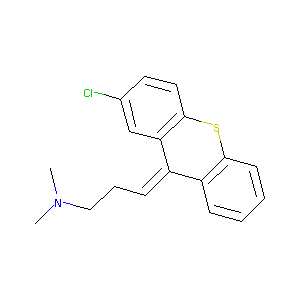Drug Information
| Drug General Information | Top | |||
|---|---|---|---|---|
| Drug ID |
D0B0CP
|
|||
| Former ID |
DAP000833
|
|||
| Drug Name |
Chlorprothixene
|
|||
| Synonyms |
Chloroprothixene; Chlorprothixen; Chlorprothixenum; Chlorprothixine; Chlorprotixen; Chlorprotixene; Chlorprotixine; Chlothixen; Clorprotisene; Clorprotixeno; Iaractan; Paxyl; Rentovet; Tactaran; Taractan; Tarasan; Tardan; Traquilan; Trictal; Truxal; Truxaletten; Truxil; Vetacalm; Clorprotisene [DCIT]; MK 184; N 714; N 714C; NCI56378; Alpha-Chlorprothixene; Chlorprothixenum [INN-Latin]; Cis-Chlorprothixene; Clorprotixeno [INN-Spanish]; N-714; Ro 4-0403; Taractan (TN); Truxal (TN); Ro-4-0403;Trans(E)-Chlorprothixen; Chlorprothixene (JAN/USAN/INN); Chlorprothixene [USAN:INN:BAN:JAN]; Cloxan, Taractan, Truxal, Chlorprothixene; Cis-2-Chloro-9-(3-dimethylaminopropylidene)thioxanthene; {3-[2-Chloro-thioxanthen-(9Z)-ylidene]-propyl}-dimethyl-amine; Thioxanthene-delta9,gamma-propylamine, 2-chloro-N,N-dimethyl-, (Z)-(8CI); (3E)-3-(2-chloro-9H-thioxanthen-9-ylidene)-N,N-dimethylpropan-1-amine; (3E)-3-(2-chlorothioxanthen-9-ylidene)-N,N-dimethylpropan-1-amine; (3Z)-3-(2-chloro-9H-thioxanthen-9-ylidene)-N,N-dimethylpropan-1-amine; (3Z)-3-(2-chlorothioxanthen-9-ylidene)-N,N-dimethylpropan-1-amine; (Z)-2-Chloro-9-(omega-dimethylaminopropylidene)thioxanthene; (Z)-2-Chloro-N,N-dimethylthioxanthene-.DELTA.(sup9),(sup.gamma.)-propylamine; (Z)-2-Chloro-N,N-dimethylthioxanthene-delta(sup 9,gamma)-propylamine; (alpha.-2-Chloro-9-.omega.-dimethylamino-propylamine)thioxanthene; 2-Chloro-9-[.omega.-(dimethylamino)propylidene]thioxanthene; 2-Chloro-9-[3-(dimethylamino)propylidene]thioxanthene; 2-Chloro-N,N-dimethylthioxanthene-.delta.(sup 9), .gamma.-propylamine; 3-(2-chloro-9H-thioxanthen-9-ylidene)-N,N-dimethyl-1-propanamine; 3-(2-chloro-9H-thioxanthen-9-ylidene)-N,N-dimethylpropan-1-amine; 3-(2-chlorothioxanthen-9-ylidene)-N,N-dimethylpropan-1-amine
Click to Show/Hide
|
|||
| Drug Type |
Small molecular drug
|
|||
| Indication | Psychotic disorder [ICD-11: 6A20-6A25] | Approved | [1] | |
| Therapeutic Class |
Antipsychotic Agents
|
|||
| Structure |
 |
Download2D MOL |
||
| Formula |
C18H18ClNS
|
|||
| Canonical SMILES |
CN(C)CCC=C1C2=CC=CC=C2SC3=C1C=C(C=C3)Cl
|
|||
| InChI |
1S/C18H18ClNS/c1-20(2)11-5-7-14-15-6-3-4-8-17(15)21-18-10-9-13(19)12-16(14)18/h3-4,6-10,12H,5,11H2,1-2H3/b14-7-
|
|||
| InChIKey |
WSPOMRSOLSGNFJ-AUWJEWJLSA-N
|
|||
| CAS Number |
CAS 113-59-7
|
|||
| PubChem Compound ID | ||||
| PubChem Substance ID |
10154, 81732, 616473, 7847855, 9276657, 14950525, 26665646, 29217891, 47424343, 47869779, 48318550, 56394950, 57408480, 74621737, 81093297, 90534681, 103237480, 104098333, 104253371, 109612796, 109839929, 117740987, 124634843, 124757488, 125141149, 125164292, 134338113, 135692269, 137171624, 141696535, 170507547, 176484799, 177749223, 179038843, 179116620, 187072594, 198936237, 210279417, 210281740, 225203928, 226471863, 226471864, 251911945, 251915022, 252219919
|
|||
| ChEBI ID |
CHEBI:50931
|
|||
| SuperDrug ATC ID |
N05AF03
|
|||
| SuperDrug CAS ID |
cas=000113597
|
|||
| Interaction between the Drug and Microbe | Top | |||
|---|---|---|---|---|
| The Abundace of Studied Microbe(s) Regulated by Drug | ||||
| The Order in the Taxonomic Hierarchy of the following Microbe(s): Bacteroidales | ||||
|
Studied Microbe: Bacteroides ovatus
Show/Hide Hierarchy
|
[2] | |||
| Hierarchy | ||||
| Abundance Change | Decrease | |||
| Experiment Method | High-throughput screening | |||
| Description | The abundance of Bacteroides ovatus was decreased by Chlorprothixene hydrochloride (adjusted p-values: 1.96E-03). | |||
|
Studied Microbe: Bacteroides thetaiotaomicron
Show/Hide Hierarchy
|
[2] | |||
| Hierarchy | ||||
| Abundance Change | Decrease | |||
| Experiment Method | High-throughput screening | |||
| Description | The abundance of Bacteroides thetaiotaomicron was decreased by Chlorprothixene hydrochloride (adjusted p-values: 4.63E-04). | |||
|
Studied Microbe: Bacteroides vulgatus
Show/Hide Hierarchy
|
[2] | |||
| Hierarchy | ||||
| Abundance Change | Decrease | |||
| Experiment Method | High-throughput screening | |||
| Description | The abundance of Bacteroides vulgatus was decreased by Chlorprothixene hydrochloride (adjusted p-values: 3.80E-04). | |||
|
Studied Microbe: Parabacteroides distasonis
Show/Hide Hierarchy
|
[2] | |||
| Hierarchy | ||||
| Abundance Change | Decrease | |||
| Experiment Method | High-throughput screening | |||
| Description | The abundance of Parabacteroides distasonis was decreased by Chlorprothixene hydrochloride (adjusted p-values: 7.77E-04). | |||
|
Studied Microbe: Parabacteroides merdae
Show/Hide Hierarchy
|
[2] | |||
| Hierarchy | ||||
| Abundance Change | Decrease | |||
| Experiment Method | High-throughput screening | |||
| Description | The abundance of Parabacteroides merdae was decreased by Chlorprothixene hydrochloride (adjusted p-values: 2.16E-03). | |||
|
Studied Microbe: Prevotella copri
Show/Hide Hierarchy
|
[2] | |||
| Hierarchy | ||||
| Abundance Change | Decrease | |||
| Experiment Method | High-throughput screening | |||
| Description | The abundance of Prevotella copri was decreased by Chlorprothixene hydrochloride (adjusted p-values: 3.32E-03). | |||
| The Order in the Taxonomic Hierarchy of the following Microbe(s): Coriobacteriales | ||||
|
Studied Microbe: Collinsella aerofaciens
Show/Hide Hierarchy
|
[2] | |||
| Hierarchy | ||||
| Abundance Change | Decrease | |||
| Experiment Method | High-throughput screening | |||
| Description | The abundance of Collinsella aerofaciens was decreased by Chlorprothixene hydrochloride (adjusted p-values: 6.09E-03). | |||
| The Order in the Taxonomic Hierarchy of the following Microbe(s): Verrucomicrobiales | ||||
|
Studied Microbe: Akkermansia muciniphila
Show/Hide Hierarchy
|
[2] | |||
| Hierarchy | ||||
| Abundance Change | Decrease | |||
| Experiment Method | High-throughput screening | |||
| Description | The abundance of Akkermansia muciniphila was decreased by Chlorprothixene hydrochloride (adjusted p-values: 1.02E-05). | |||
| References | Top | |||
|---|---|---|---|---|
| REF 1 | FDA Approved Drug Products from FDA Official Website. 2009. Application Number: (NDA) 016149. | |||
| REF 2 | Extensive impact of non-antibiotic drugs on human gut bacteria. Nature. 2018 Mar 29;555(7698):623-628. | |||
| REF 3 | Potential utility of histamine H3 receptor antagonist pharmacophore in antipsychotics. Bioorg Med Chem Lett. 2009 Jan 15;19(2):538-42. | |||
If You Find Any Error in Data or Bug in Web Service, Please Kindly Report It to Dr. Zhou and Dr. Zhang.

